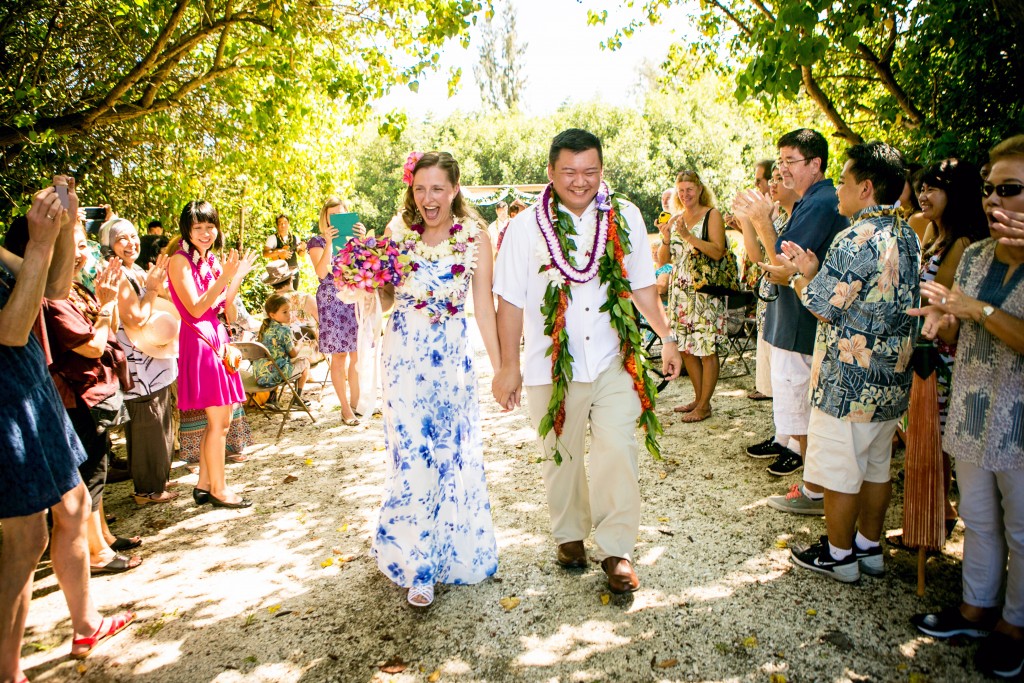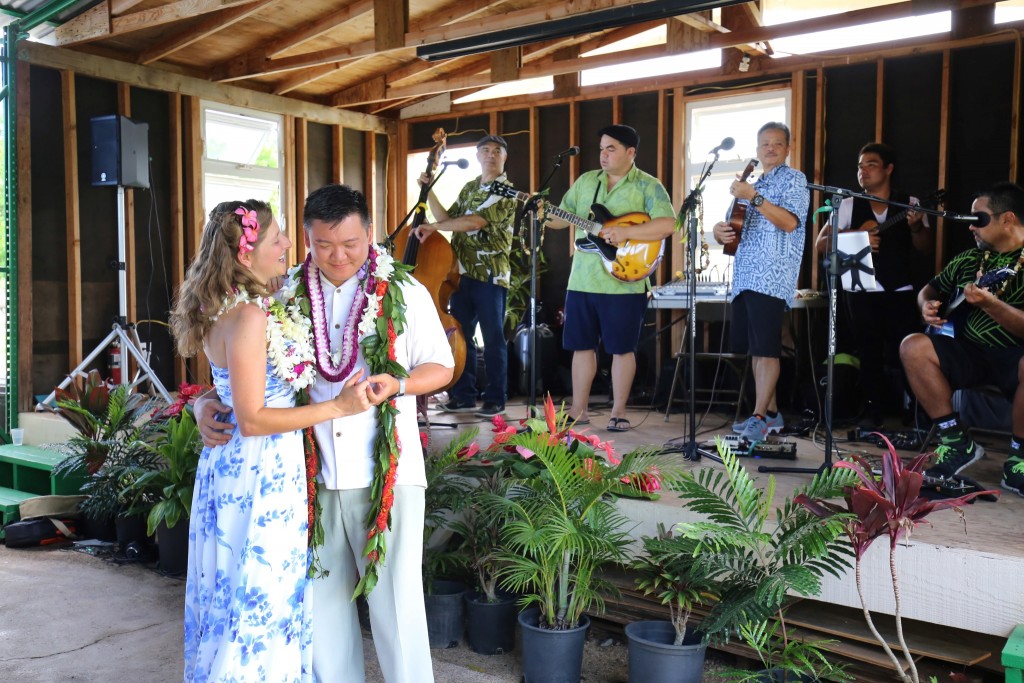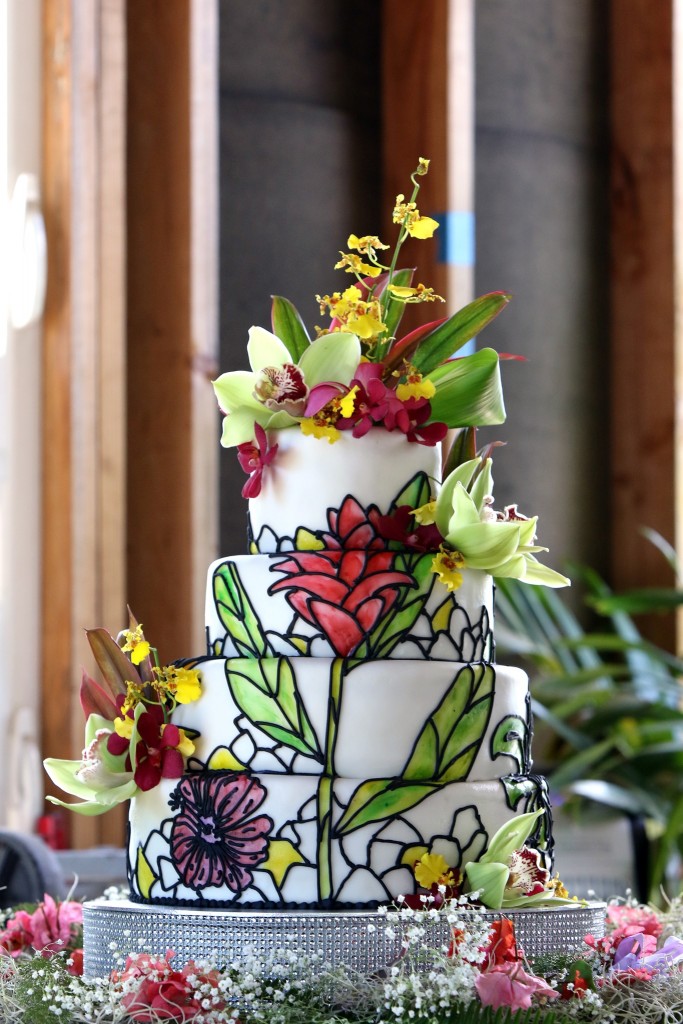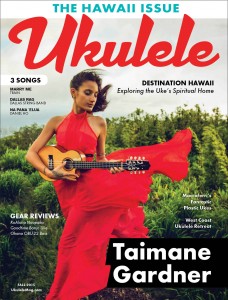Wednesday, September 30, 2015
Tuesday, September 29, 2015
You Are My Sunshine for Ukulele - 21 Songs in 6 Days: Learn Ukulele the Easy Way
 http://ukulele.io/Buy21Songs Learn to play ukulele the easy way with "21 Songs in 6 Days". And visit our website for more great ukulele FREE STUFF http://ukulele.io/free-stuff-offer
http://ukulele.io/Buy21Songs Learn to play ukulele the easy way with "21 Songs in 6 Days". And visit our website for more great ukulele FREE STUFF http://ukulele.io/free-stuff-offerhttps://youtu.be/2Drwh7cKEUk - You Are My Sunshine for Ukulele - 21 Songs in 6 Days: Learn Ukulele the Easy Way
Here's Jenny's version of this great classic song. She uses a cool syncopated strum, but you could also do all down strums to get yourself started.
To learn lots more ukulele chords, try our playlist https://www.youtube.com/playlist?list=PL5meDCz5zO-B8UjXstv_2WurNRGJyyWz8.
To spice up your strumming, try our playlist https://www.youtube.com/playlist?list=PL5meDCz5zO-DD1mcV8_t_tuga9MzOJA46
Want to learn to play the theme music from our intro? Check out https://youtu.be/YznUjC8pnUQ.
“You Are My Sunshine” was first recorded in 1939. It has been declared one of the state songs of Louisiana because of its association with former state governor and country music singer Jimmie Davis. Virginia Shehee, a long-time Davis family friend and member of the Louisiana State Senate from 1976 to 1980, introduced legislation to make "You Are My Sunshine" the official state song.
The song has been covered so many times that it has moved out of country music and into mainstream pop culture. In 1941, it was covered by Gene Autry, Bing Crosby, Mississippi John Hurt and Lawrence Welk. In subsequent years, it was covered by Nat King Cole (1955), Ray Charles,Ike and Tina Turner, The Rivingtons (1962), Frank Turner, Aretha Franklin, Johnny Cash, Brian Wilson, Mouse and the Traps, Jamey Johnson, Low and Andy Williams, and many others.
The song occurs frequently in the film “O Brother Wherefore Art Thou”.
The 1940 version by Davis has been added to the National Recording Registry in the Library of Congress on March 21, 2013 for long-term preservation.
You Are My Sunshine Ukulele, ukulele songs, easy ukulele songs for beginners, ukulele, ukulele songs for beginners, easy ukulele songs, beginner ukulele songs
You Are My Sunshine for Ukulele - 21 Songs in 6 Days: Learn Ukulele the...
http://ukulele.io/Buy21Songs Learn to play ukulele the easy way with "21 Songs in 6 Days". And visit our website for more great ukulele FREE STUFF http://ukulele.io/free-stuff-offer
https://youtu.be/2Drwh7cKEUk - You Are My Sunshine for Ukulele - 21 Songs in 6 Days: Learn Ukulele the Easy Way
Here's Jenny's version of this great classic song. She uses a cool syncopated strum, but you could also do all down strums to get yourself started.
To learn lots more ukulele chords, try our playlist https://www.youtube.com/playlist?list=PL5meDCz5zO-B8UjXstv_2WurNRGJyyWz8.
To spice up your strumming, try our playlist https://www.youtube.com/playlist?list=PL5meDCz5zO-DD1mcV8_t_tuga9MzOJA46
Want to learn to play the theme music from our intro? Check out https://youtu.be/YznUjC8pnUQ.
“You Are My Sunshine” was first recorded in 1939. It has been declared one of the state songs of Louisiana because of its association with former state governor and country music singer Jimmie Davis. Virginia Shehee, a long-time Davis family friend and member of the Louisiana State Senate from 1976 to 1980, introduced legislation to make "You Are My Sunshine" the official state song.
The song has been covered so many times that it has moved out of country music and into mainstream pop culture. In 1941, it was covered by Gene Autry, Bing Crosby, Mississippi John Hurt and Lawrence Welk. In subsequent years, it was covered by Nat King Cole (1955), Ray Charles,Ike and Tina Turner, The Rivingtons (1962), Frank Turner, Aretha Franklin, Johnny Cash, Brian Wilson, Mouse and the Traps, Jamey Johnson, Low and Andy Williams, and many others.
The song occurs frequently in the film “O Brother Wherefore Art Thou”.
The 1940 version by Davis has been added to the National Recording Registry in the Library of Congress on March 21, 2013 for long-term preservation.
You Are My Sunshine Ukulele, ukulele songs, easy ukulele songs for beginners, ukulele, ukulele songs for beginners, easy ukulele songs, beginner ukulele songs
Monday, September 28, 2015
How to Play Happy Birthday on Ukulele
 http://ukulele.io/Buy21Songs - Learn to play ukulele the easy way with "21 Songs in 6 Days"
http://ukulele.io/Buy21Songs - Learn to play ukulele the easy way with "21 Songs in 6 Days"http://youtu.be/0nQYxVwZ5AY Beginner Ukulele Songs - How to Play Happy Birthday on Ukulele - 21 Songs in 6 Days
Here's a great beginner ukulele song - only three chords: C, F and G7. We've simplified the strum to make this one super easy so you can sing and play it even if you're just starting to learn how to play ukulele. If you don't know the three chords, click on over to our playlist "How to Play Ukulele Chords" at http://www.youtube.com/playlist?list=PL5meDCz5zO-B8UjXstv_2WurNRGJyyWz8 for lots of helpful tips.
Don't forget, if you want to learn how to play ukulele, get your copy of ”21 Songs in 6 Days: Learn Ukulele the Easy Way” now at
http://ukulele.io/Buy21Songs
Visit our website for a free beginning ukulele course to get you started playing today!
http://ukulele.io/free-stuff-offer
"Happy Birthday to You", is also known more simply as "Happy Birthday”. According to the 1998 Guinness World Records, "Happy Birthday to You" is the most recognized song in the English language, followed by "For He's a Jolly Good Fellow". The song's base lyrics have been translated into at least 18 languages. The melody of "Happy Birthday to You" comes from the song "Good Morning to All", which has been attributed to American siblings Patty Hill and Mildred J. Hill in 1893.
Patty Hill was a kindergarten principal in Louisville, Kentucky, developing various teaching methods at what is now the Little Loomhouse. Her sister Mildred was a pianist and composer. The sisters used "Good Morning to All" as a song that young children would find easy to sing. The Hill Sisters' students enjoyed their teachers' version of "Good Morning to All" so much that they began spontaneously singing it at birthday parties, changing the lyrics to "Happy Birthday”.
The combination of melody and lyrics in "Happy Birthday to You" first appeared in print in 1893, in their songbook “Song Stories for the Kindergarten”. Kembrew McLeod stated that the Hill sisters likely copied the tune and lyrical idea from other popular and similar nineteenth-century songs that predated theirs, including Horace Waters' "Happy Greetings to All", "Good Night to You All" also from 1858, "A Happy New Year to All" from 1875, and "A Happy Greeting to All", published 1885. However, other researchers dispute this, noting that these earlier songs had quite different melodies.
One of the most famous performances of "Happy Birthday to You" was Marilyn Monroe's rendition to U.S. President John F. Kennedy in May 1962. Another notable use was by comedy pianist Victor Borge, who played the song in styles of various composers, or would begin playing “Moonlight Sonata,” smoothly transitioning into the song.
Some more interesting recent performances of “Happy Birthday” include:
On August 5, 2013, the first anniversary of its landing on Mars, NASA's Curiosity rover celebrated its "birthday" when engineers at Goddard Space Flight Center used the Sample Analysis at Mars (SAM) instrument to cause the rover to "sing" Happy Birthday on the Martian surface.
During the March 6, 2014 episode of the Comedy Central series The Colbert Report, Stephen Colbert planned to sing the song in honor of the 90th anniversary of its 1924 publication, but was "forced" to sing a new "royalty-free" version—set to "The Star-Spangled Banner", instead, due to the copyright issues.
Ukulele Songs, Happy Birthday ukulele, how to play Happy Birthday on ukulele
Beginner Ukulele Songs - How to Play Happy Birthday on Ukulele - 21 Song...
http://ukulele.io/Buy21Songs - Learn to play ukulele the easy way with "21 Songs in 6 Days"
http://youtu.be/0nQYxVwZ5AY Beginner Ukulele Songs - How to Play Happy Birthday on Ukulele - 21 Songs in 6 Days
Here's a great beginner ukulele song - only three chords: C, F and G7. We've simplified the strum to make this one super easy so you can sing and play it even if you're just starting to learn how to play ukulele. If you don't know the three chords, click on over to our playlist "How to Play Ukulele Chords" at http://www.youtube.com/playlist?list=PL5meDCz5zO-B8UjXstv_2WurNRGJyyWz8 for lots of helpful tips.
Don't forget, if you want to learn how to play ukulele, get your copy of ”21 Songs in 6 Days: Learn Ukulele the Easy Way” now at
http://ukulele.io/Buy21Songs
Visit our website for a free beginning ukulele course to get you started playing today!
http://ukulele.io/free-stuff-offer
"Happy Birthday to You", is also known more simply as "Happy Birthday”. According to the 1998 Guinness World Records, "Happy Birthday to You" is the most recognized song in the English language, followed by "For He's a Jolly Good Fellow". The song's base lyrics have been translated into at least 18 languages. The melody of "Happy Birthday to You" comes from the song "Good Morning to All", which has been attributed to American siblings Patty Hill and Mildred J. Hill in 1893.
Patty Hill was a kindergarten principal in Louisville, Kentucky, developing various teaching methods at what is now the Little Loomhouse. Her sister Mildred was a pianist and composer. The sisters used "Good Morning to All" as a song that young children would find easy to sing. The Hill Sisters' students enjoyed their teachers' version of "Good Morning to All" so much that they began spontaneously singing it at birthday parties, changing the lyrics to "Happy Birthday”.
The combination of melody and lyrics in "Happy Birthday to You" first appeared in print in 1893, in their songbook “Song Stories for the Kindergarten”. Kembrew McLeod stated that the Hill sisters likely copied the tune and lyrical idea from other popular and similar nineteenth-century songs that predated theirs, including Horace Waters' "Happy Greetings to All", "Good Night to You All" also from 1858, "A Happy New Year to All" from 1875, and "A Happy Greeting to All", published 1885. However, other researchers dispute this, noting that these earlier songs had quite different melodies.
One of the most famous performances of "Happy Birthday to You" was Marilyn Monroe's rendition to U.S. President John F. Kennedy in May 1962. Another notable use was by comedy pianist Victor Borge, who played the song in styles of various composers, or would begin playing “Moonlight Sonata,” smoothly transitioning into the song.
Some more interesting recent performances of “Happy Birthday” include:
On August 5, 2013, the first anniversary of its landing on Mars, NASA's Curiosity rover celebrated its "birthday" when engineers at Goddard Space Flight Center used the Sample Analysis at Mars (SAM) instrument to cause the rover to "sing" Happy Birthday on the Martian surface.
During the March 6, 2014 episode of the Comedy Central series The Colbert Report, Stephen Colbert planned to sing the song in honor of the 90th anniversary of its 1924 publication, but was "forced" to sing a new "royalty-free" version—set to "The Star-Spangled Banner", instead, due to the copyright issues.
Ukulele Songs, Happy Birthday ukulele, how to play Happy Birthday on ukulele
Friday, September 25, 2015
Thursday, September 24, 2015
Jenny I Got Your Number for Ukulele - 21 Songs in 6 Days: Learn Ukulele the Easy Way
 http://ukulele.io/Buy21Songs Learn to play ukulele the easy way with "21 Songs in 6 Days". And visit our website for more great ukulele lessons, tabs, and a FREE ebook http://ukulele.io/free-stuff-offer
http://ukulele.io/Buy21Songs Learn to play ukulele the easy way with "21 Songs in 6 Days". And visit our website for more great ukulele lessons, tabs, and a FREE ebook http://ukulele.io/free-stuff-offerhttps://youtu.be/V9GbN5u2JD8 - Jenny I Got Your Number for Ukulele
Visit http://ukulele.io/jenny-i-got-your-number/ to download a pdf of lyrics and chord changes for this song.
"867-5309/Jenny” also called “Jenny I Got Your Number” is a song written by Alex Call and Jim Keller and performed by Tommy Tutone that was released on the album Tommy Tutone 2, on the Columbia Records label. It peaked at #4 on the Billboard Hot 100 chart and #16 on the Billboard Top Tracks chart in 1982.
The song caused a fad of people dialing 867-5309 and asking for "Jenny".
Was Jenny a real person?
Lead guitarist Jim Keller, interviewed by People in 1982, said "Jenny is a regular girl, not a hooker. Friends of mine wrote her name and number on a men's room wall at a bar. I called her on a dare, and we dated for a while. I haven't talked with her since the song became a hit, but I hear she thinks I'm a real jerk for writing it."
On March 28, 2008, Tommy Tutone lead singer Tommy Heath stated on the WGN Morning Newsthat the number was real and it was the number of a girl he knew. As a joke, he wrote it on a bathroom wall in a motel where they were staying.
"There was no Jenny," songwriter Alex Call told a Tampa, Florida, columnist in June 2009. "The number? It came to me out of the ether."
Apparently the number 867-5309 has lodged into people’s minds in a big way. A study on the security of numerical passwords in 2012 revealed that 8675309 is the fourth most common 7-digit password, speculating that it is easy to remember because of the popularity of this song, despite being otherwise fairly random (as opposed to the #1 most common 7-digit password: 1234567)
To learn lots more ukulele chords, try our playlist https://www.youtube.com/playlist?list=PL5meDCz5zO-B8UjXstv_2WurNRGJyyWz8.
To spice up your strumming, try our playlist https://www.youtube.com/playlist?list=PL5meDCz5zO-DD1mcV8_t_tuga9MzOJA46
Want to learn to play the theme music from our intro? Check out https://youtu.be/YznUjC8pnUQ.
ukulele songs, easy ukulele songs for beginners, ukulele, ukulele songs for beginners, easy ukulele songs, beginner ukulele songs
Watch Uker Edward Hernandez Absolutely Slay Aerosmith’s ‘Dream On’
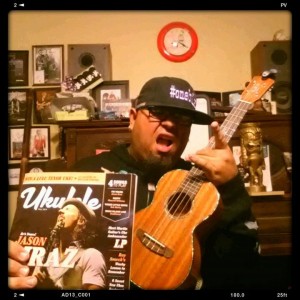
Reader Edward Hernandez sent us a video of him covering Aerosmith’s “Dream On” on his Teton electric ukulele and we can’t stop watching it.
Not only does Edward nail the nuanced rhythms of the song, he also pulls off the dramatic finale—giving Steven Tyler a run for his money!
Tuesday, September 22, 2015
Monday, September 21, 2015
Jenny I Got Your Number for Ukulele - 21 Songs in 6 Days: Learn Ukulele ...
Our newest video lesson. Fun 80's pop song. Enjoy!
Wednesday, September 16, 2015
Garfunkel and Oates New Album Out Now, Watch the Video for ‘Fadeaway’

The adorable, irresistible, hilarious guitar-ukulele duo Garfunkel and Oates has taken a break from its IFC show to release a new album called Secretions.
Watch in the above video as Kate “Oates” Micucci (on uke) and Riki “Garfunkel” Lindhome (on guitar) explain the classic dating ritual of the “Fadeaway.”
Get your copy of Secretions at Amazon.
Tuesday, September 15, 2015
Saturday, September 12, 2015
May We Present Mr. and Mrs. Ukulele…Craig Chee and Sarah Maisel
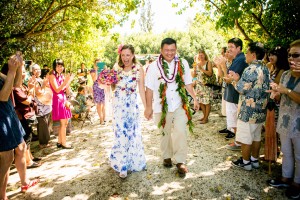
Last weekend, ukulele’s favorite couple, Craig Chee and Sarah Maisel, tied the knot on the North Shore of Oahu.
As expected, this was an all-star ukulele affair, held at the river-and-ocean-side property of the Gamiaos, which we visited in April to interview Kalei Gamiao, who you’ll see below serenading the couple along with Bryan Tolentino and Halehaku Seabury.
Of course, Craig and Sarah also performed, playing custom ukes built by Joe Souza of Kanile`a. Our friends at Hawaii Music Supply posted a video of the couple’s first duet as newlyweds, which you can watch below.
Learn how these lovebirds went from uke partners to life partners in this feature from our Summer 2014 issue.
CONGRATS Sarah & Craig!
Thursday, September 10, 2015
Monday, September 7, 2015
Style: Finding Your Sound
An abstract look at an abstract concept: learning to play the 'ukulele like you. Here I share some observations on imitation and discovering the sound in your head.
Yesterday Easy Ukulele Song - 21 Songs in 6 Days: Learn Ukulele the Easy...
http://ukulele.io/Buy21Songs Learn to play ukulele the easy way with "21 Songs in 6 Days". And visit our website for more great ukulele lessons, tabs, and a FREE ebook http://ukulele.io/free-stuff-offer
http://youtu.be/NrVRZ-3E4uQ Yesterday Easy Ukulele Song - 21 Songs in 6 Days: Learn Ukulele the Easy Way
McCartney's vocal and acoustic guitar together with a string quartet essentially made for the first solo performance of the band. It remains popular today with more than 2,200 cover versions and is one of the most covered songs in the history of recorded music."Yesterday" was voted the best song of the 20th century in a 1999 BBC Radio 2 poll of music experts and listeners and was also voted the No. 1 pop song of all time by MTV and Rolling Stone magazine the following year. In 1997, the song was inducted into the Grammy Hall of Fame. Broadcast Music Incorporated (BMI) asserts that it was performed over seven million times in the 20th century alone.
"Yesterday" is a melancholy ballad about the break-up of a relationship. McCartney is the only member of the Beatles to appear on the recording. The final recording was so different from other works by the Beatles that the band members vetoed the release of the song as a single in the United Kingdom. However, it was issued as a U.S. single in 1965 and reissued there in 1976. The Beatles' influence over their US record label, Capitol, was not as strong as it was over EMI's Parlophone in Britain. A single was released in the US, pairing "Yesterday" with "Act Naturally", a track which featured vocals by Starr. The single was released on 13 September 1965 and topped the Billboard Hot 100 chart for four weeks, beginning on 9 October. The song spent a total of 11 weeks on the chart, selling a million copies within five weeks. The single was also number one for three weeks on the U.S. Cashbox pop singles chart the same year.
John Lennon said "The song was around for months and months before we finally completed it. Every time we got together to write songs for a recording session, this one would come up. We almost had it finished. Paul wrote nearly all of it, but we just couldn't find the right title. We called it 'Scrambled Eggs' and it became a joke between us. We made up our minds that only a one-word title would suit, we just couldn't find the right one. Then one morning Paul woke up and the song and the title were both there, completed. I was sorry in a way, we'd had so many laughs about it."
"Yesterday" won the Ivor Novello Award for 'Outstanding Song of 1965', and came second for 'Most Performed Work of the Year', losing out to the Lennon/McCartney composition, "Michelle". The song has received its fair share of acclaim in recent times as well, ranking 13th on Rolling Stone's 2004 list "The 500 Greatest Songs of All Time" and fourth on the magazine's list "The Beatles 100 Greatest Songs" (compiled in 2010).[41][42] In 1999, Broadcast Music Incorporated (BMI) placed "Yesterday" third on their list of songs of the 20th century most performed on American radio and television, with approximately seven million performances. "Yesterday" was surpassed only by The Association's "Never My Love" and the Righteous Brothers' "You've Lost That Loving Feeling"."Yesterday" was voted Best Song of the 20th century in a 1999 BBC Radio 2 poll.
The song was inducted into the Grammy Hall of Fame in 1997. Although the song was nominated for Song of the Year at the 1966 Grammy Awards, it ultimately lost to Tony Bennett's "The Shadow of Your Smile."In an interview with one of McCartney's influences, Chuck Berry said that "Yesterday" was the song that he wished that he had written.
"Yesterday", however, has also been criticized for being mundane and mawkish; Bob Dylan had a marked dislike for the song, stating that "If you go into the Library of Congress, you can find a lot better than that. There are millions of songs like 'Michelle' and 'Yesterday' written in Tin Pan Alley". Ironically, Dylan ultimately recorded his own version of "Yesterday" four years later, but it was never released.
To learn lots more ukulele chords, try our playlist https://www.youtube.com/playlist?list=PL5meDCz5zO-B8UjXstv_2WurNRGJyyWz8.
To spice up your strumming, try our playlist https://www.youtube.com/playlist?list=PL5meDCz5zO-DD1mcV8_t_tuga9MzOJA46
Want to learn to play the theme music from our intro? Check out https://youtu.be/YznUjC8pnUQ.
Yesterday, Yesterday ukulele, Yesterday ukulele tutorial, ukulele songs, easy ukulele songs for beginners, ukulele, ukulele songs for beginners, easy ukulele songs, beginner ukulele songs
Thursday, September 3, 2015
VIDEO: Watch Herb Ohta Jr. and Bryan Tolentino Play the Ukulele Festival Hawaii
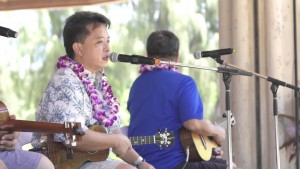
Roy Sakuma’s 45th annual Ukulele Festival Hawaii took place in Waikiki this past July, and Sakuma has posted a number of performance videos recorded at the renowned event. This video features Herb Ohta Jr. and Bryan Tolentino (joined by Halehaku Seabury) performing three songs from their new album, Ukulele Friends: “Manuela Boy,” “In a Little Hula Heaven,” and their classic original “G Minor Fleas.”
For more information about the new album, check out our review in the Fall 2015 issue. Enjoy!
Wednesday, September 2, 2015
The Aloha Spirit: Exploring Oahu With Eddie Kamae, Kalei Gamiao, and More Ukulele Idols
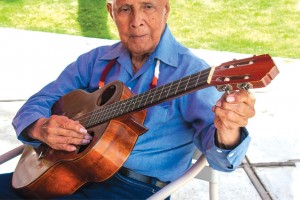
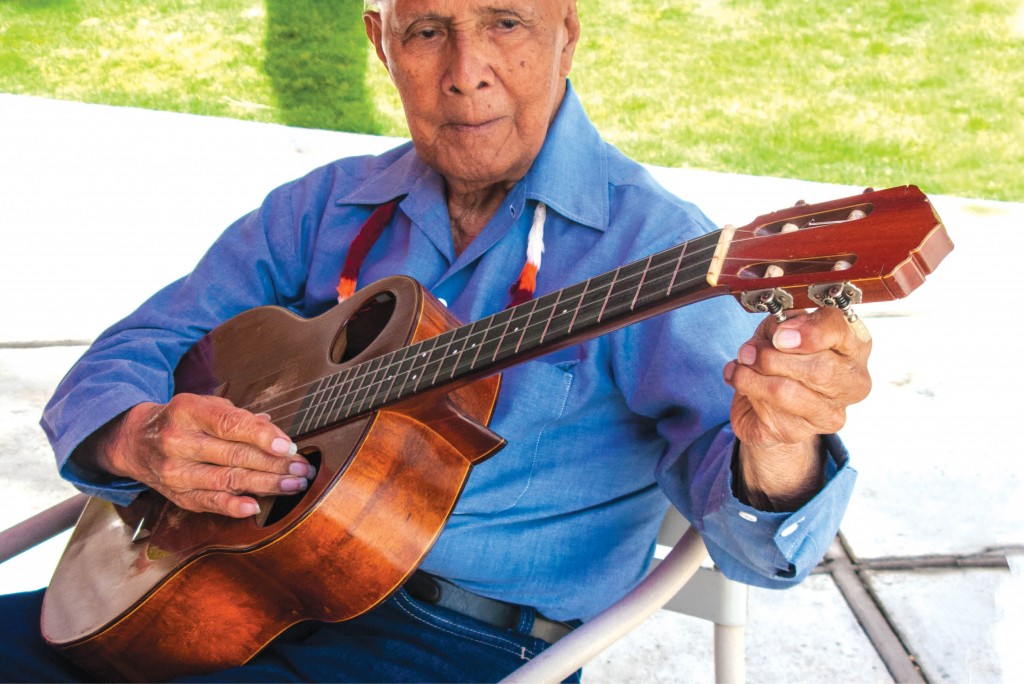
Ukulele virtuoso Eddie Kamae
It’s my last day on Oahu, and the mid-morning sky is beginning to mist. I think I might cry, too. My entire trip has led to this interview with the legendary Eddie Kamae—a ukulele virtuoso and founding member of Sons of Hawaii, a leading force in the Hawaiian cultural renaissance, and an octogenarian who traveled remote and forgotten terrain to revive his culture.
But all he wants to talk about are the birds. “Please enjoy yourself. Relax,” says Kamae, gesturing to sit down in the courtyard of the Waikiki high-rise where he’s lived for 46 years with his wife, Myrna. “The birds will come by in a little while looking for me. I always feed them. My wife says, don’t feed them. I don’t want to feed them, they just come around.”
Sure enough, a zebra dove boldly hops onto the table, just inches away, as more birds gather around Kamae’s feet—tan, weathered, and clad in rubber flip-flops.
Kamae begins to feed them from a packet of saltines, which he had tucked into the pocket of his crisp denim shirt during our lunch at the nearby Wailana Coffee House.
“It’s good to feed the animals. They get close to you. They adopt you,” he says, pointing to “the fat one” and explaining that “he’s the oldest.”
In the five days I’ve been in Hawaii—meeting dozens of players, instrument makers, and enthusiasts—the ukulele has not been discussed without a mention of the contributions of Kamae, who in the 1950s helped make the ukulele a respected solo instrument.
Myrna and my brother, Christopher, who is traveling as my photographer, have gone to fetch his ukes, and we are alone. I have so many questions: How did he develop his innovative picking style? How did he learn, at such a young age and with no formal training, to arrange complex Latin songs for ukulele? What does he want for Hawaii’s next generation of ukulele players? Kamae nods at my rapid-fire questions, dismissing the birds by clapping his hands and demanding, “OK gang, go away!”
Finally, he looks at me with his kind, patient eyes and slowly replies, “You can be a Superman player, but that’s not the point. Play from the heart.”
In that moment, I grasp what everyone on the island has been telling me—with actions, not words—about the soul of ukulele music in Hawaii: It is aloha.
Aloha
I’d been to Hawaii once before, as a sullen 21-year-old searching for dive bars and trouble in Lahaina while my mom baked on the beach. I was in Maui to visit my paternal grandfather, who had moved in with my aunt after my grandmother died. My aunt had tried to explain aloha to me, placing a puakenikeni lei around my neck and holding my shoulders for a moment after, attempting to exchange “the breath of life” (ha). I still recall the sweet scent of that lei, the way fish there tasted different, better (ono), and the Wo Hing Temple and the nearby Seamen’s Cemetery, two symbols of the old town tucked amid trinket shops. I remember resenting the tourists, yet feeling like an outsider (haole) among the Hawaiians. I returned to California as pale as I had left it, no puka shells around my neck, no true longing for the island in my heart.
One of Eddie Kamae’s mentors, Pilahi Paki famously defined the word “aloha” in 1970, as detailed in Kamae’s book Hawaiian Son: The Life and Music of Eddie Kamae, co-written with James D. Houston. At a four-day conference called “Hawaii 2000,” where local leaders and international attendees discussed their vision for the future of the still new state, Paki stood up during a packed question-and-answer session, waited for her chance to speak, and, after a long pause, said: “I would like you to understand that aloha spirit is a coordination of mind and heart. It is within the individual. It brings you down to yourself. You must think and emote good feelings to others.”
Ohana
I enter the Honolulu airport, slightly buzzed from a complimentary airline mai tai, and pause to look at an atrium filled with lush greenery, remembering how beautiful this place is—even the airport. The Hawaiian humidity clings to my skin like a sweater. I hop in a cab and head to the Moiliili neighborhood, which sits between Waikiki and the University of Hawaii, to meet Byron Yasui, who has taught music theory and composition since the ’70s. Now retired, Yasui was in the midst of writing a concerto for ukulele—to be performed by Jake Shimabukuro with the Hawaii Symphony—when I called and asked for an interview. He gave me detailed directions to a Chinese restaurant, where he and local ukulele players meet every Thursday (“. . . including Jake, if he’s in town,” which he wasn’t that week). “Be there by noon,” Yasui said, explaining that he didn’t text—if my plans changed, I should call him.
When I arrive at the restaurant, a row of hanging red lanterns lining its exterior and small dragon statues guarding its front door, Yasui is waiting outside. He brings me to a table where a small group sits and strums ukuleles while the rest of the diners share plates of Hong Kong and Northern Chinese specialties on lazy Susans. They don’t seem to notice, or care, that five of the finest ukulele players I’d ever met are sitting nearby—it’s just a typical day in Honolulu, where good food and good music are abundant.
Yasui—or “Uncle Byron,” as many call him—introduces me to the group: Bryan Tolentino, who immediately hands me a CD of his just-released album, ‘Ukulele Friends, with Herb Ohta Jr. (also a regular at these gatherings); Raiatea Helm, a Grammy-nominated singer in the leo ki`eki`e (falsetto) style, whom Tolentino frequently accompanies, and who can hold her own as a player; Benny Chong, the longtime guitarist for Don Ho’s backing band, the Ali`is, who emerged late in his career as a jazz-ukulele virtuoso, though, like most Hawaiians, he had been playing the instrument since childhood; and Halehaku “Hale” Seabury, a guitarist and uker who can play brilliantly right- and left-handed. Yasui himself is best known as a double bassist, having performed with such jazz legends as Ernie Washington, and for his classical-guitar duo with Brazilian virtuoso Carlos Barboso-Lima. But on this warm April afternoon, everyone at the table is there to talk about one thing only—the instrument that has brought them to this restaurant every week for the past 15 years for what Yasui calls their “ukulele summit”—a chance to play and learn from each other.
Those first few years, it was just Yasui and Chong, says Tolentino, asking, “Did Byron tell you about 2001?”
I shake my head. Over passed plates of pork ribs, lemon chicken, asparagus, pan-fried noodles, and steamed rice, Tolentino describes how a series of harrowing events brought them together in the most unlikely of scenarios: They were all near New York City the morning of September 11.
Tolentino, Yasui, Chris and Casey Kamaka (of the great ukulele-making family), and Hawaiian guitarist Asa Young were all in Montclair, New Jersey, for the Ukulele Expo, organized by the Ukulele Hall of Fame Museum.
On the morning of Tuesday, September 11, Tolentino, the Kamakas, and Young headed to Newark to fly home. Tolentino dropped off their rental car and was heading back to Newark on a tram when he got a call from Young saying, “A plane just crashed into the World Trade Center.”
Tolentino recalls being confused, not panicked: “I didn’t know what he meant. I thought that happened often. Being in Hawaii, we’re so far removed.”
The friends reunited at Newark, and watched the second plane hit Tower Two. That’s when Tolentino realized they’d have to evacuate, but to where? Tom Walsh, co-founder of the Ukulele Hall of Fame, and his wife, Nuni (the great-granddaughter of Manuel Nunes, one of the first manufacturers of ukuleles in Hawaii), picked up the stranded party and took them to their New Jersey home. On Wednesday, they bought rice and “hunkered down.” By Thursday, Yasui had escaped Manhattan and joined them.
“It was really heartwarming when I saw you guys,” Yasui recalls.
The friends stayed with the Walshes through the weekend, until flights resumed to Hawaii, playing music together and forming new bonds. Though they had known one another through the tight-knit Hawaiian music community, after September 11, they had became ohana (family).
As Helm sang “The One They Call Hawaii”—the restaurant empty and its staff gathered around our table to listen—I, too, felt like a member of their ukulele family.
Hana
At Bryan Tolentino’s recommendation, on my first night in town I head to the Waikiki Beach Marriott, to see Aunty Genoa Leilani Keawe’s granddaughter perform. I know little of Aunty Genoa, but recognize that I’m in the right place when I spot a band performing under a large portrait of an elderly woman wearing a strand of bougainvillea in her white hair and holding a ukulele. It’s Aunty Genoa, who died in 2008, at age 89. Today, the Keawe Ohana—her granddaughter Pomaika`i Keawe Lyman, son Gary Keawe Aiko, niece Momi Kahawaiola`a, and lap-steel guitarist Alan Akaka—continues her tradition of playing every Thursday night at the Marriott’s Moana Terrace. The casual, poolside bar, at first, seems like a typical tourist hangout with solo business travelers on their smartphones, loud bachelor-party guys, and couples on their honeymoon. The Hawaiian music coming from the stage and the humble musicians playing it hold the mellow energy of the breaks on Waikiki Beach. But like the waves, the Keawe Ohana takes me on an unexpected ride—one filled with tradition, culture, and expression.
In the middle of their set, the band introduces a hula dancer, a woman in her 70s wearing high-waisted jeans and a baby-blue turtleneck. She moves with the grace and fluidity of a sandhill crane. Her languid movements embody the music, not just keeping rhythm, interpreting its sounds and telling a story I don’t fully understand, but completely feel—a lump forming in my throat. I look around the terrace, self-conscious of my emotions, and notice the crowd has hushed, no one is on their phone, and the bachelor-party dudes are gone.
The Keawe Ohana seems to feel the energy shift, too. The musicians become animated as they introduce the next song—the 1930s hit “My Little Grass Shack in Kealakekua, Hawaii”—by saying it should be Hawaii’s marijuana legalization theme song. Invoking the spirit of her grandmother, Keawe Lyman’s falsetto blends perfectly with the delicate, bright tones of her ukulele—as if they are one instrument. Near the end of the set, Akaka introduces the band: “We’ve been playing here every Thursday night for the past 20 years, and we’ll be here for the next 30 years.”
They close with “God Bless America”—we all sing along.
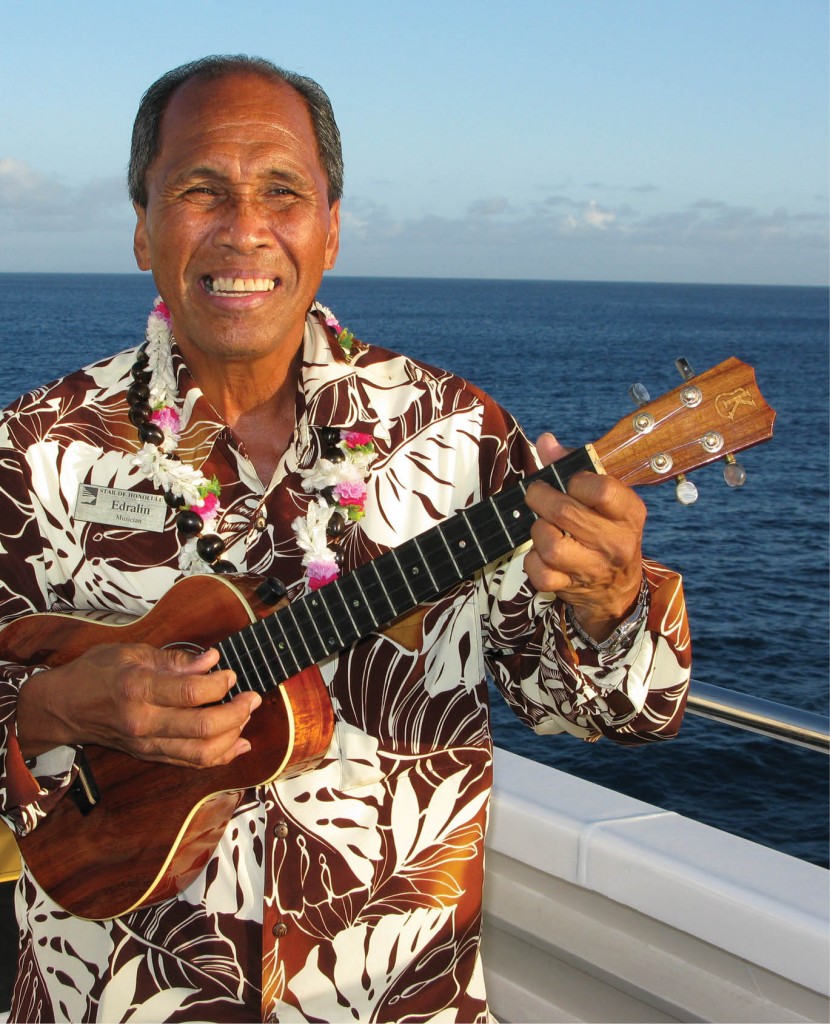
Edralin “Ace” Thompson on the Star of Honolulu sunset cruise
To my surprise, that sense of connectedness—to song, to the islands, to one another—permeates Oahu’s most touristy destinations. I had a similar experience on the Star of Honolulu sunset cruise, watching Ace Thompson’s set on the top deck just after dinner was served—the crowd digging into plates of whole Maine lobsters and steak as he began to strum “Nani Kaua`i” on his Kanile`a ukulele. The sound of cracking shellfish and knifes squeaking on plates doesn’t faze Thompson, closing his eyes as he sings about the “beauty of the glistening water” and hitting the high notes like a pro, but with the reverence of a musician just starting out. After his set, he tells me he’s been working a Star of Honolulu cruise six nights a week for 31 years, and he still cares about his craft (hana). At Germaine’s Luau, the oldest luau on Oahu, performer Kaliko Kalima-Salcedo—the daughter of Jesse Kalima, one of the first solo-ukulele virtuosos—and executive director Paulette Watson are going on 26 years with no complaints.
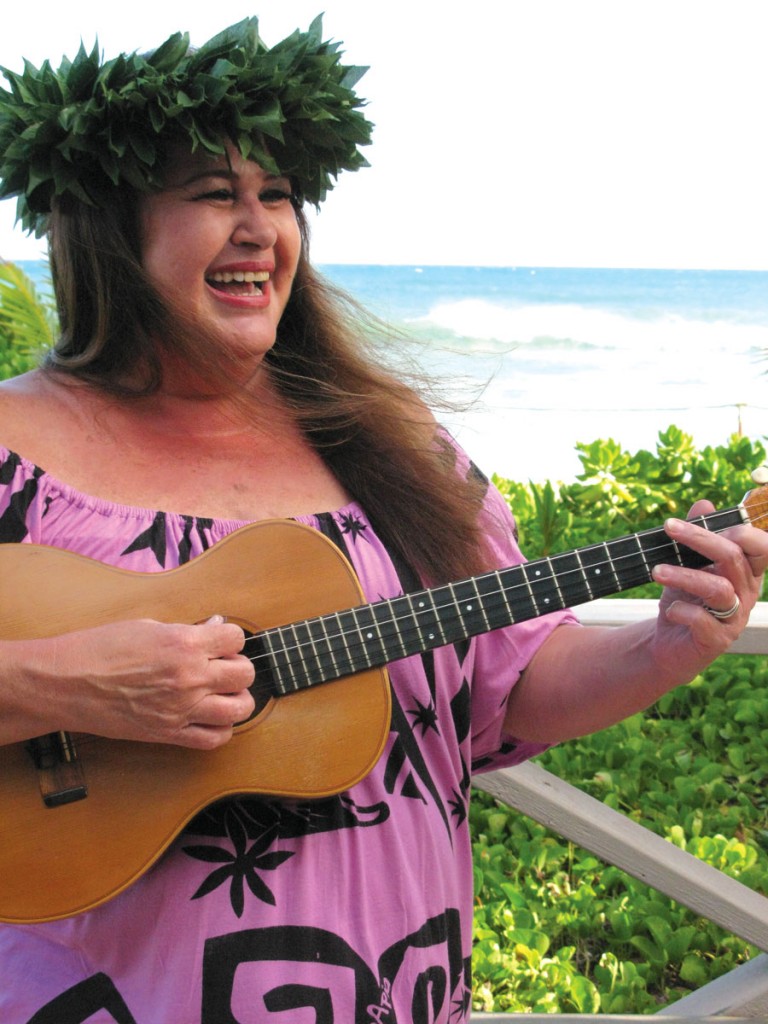
Kaliko Kalima-Salcedo, daughter of Jesse Kalima, plays her father’s 1969 Kamaka on the southwestern shore of Oahu
Kalima-Salcedo started playing ukulele at age five, first learning the Hawaiian classic “Pearly Shells,” honing her skills until she could play the B.J. Thomas hit “Raindrops Keep Fallin’ on My Head.” She never stopped playing, even as she moved onto dancing, which is how she met Watson, a featured member at Tavana’s Polynesian Spectacular at the Moana Hotel in the ’70s and ’80s. Kalima-Salcedo’s role as Germaine’s emcee brings her experience and family legacy full circle—she opens the show singing and strumming her father’s 1969 six-string Kamaka baritone; she leads traditional Hawaiian chants; and she hypes the crowd for the dances of the Pacific (Samoa, Tahiti, New Zealand, and Hawaii).
Sitting in Kalima-Salcedo’s air-conditioned dressing room before the show, surrounded by leis and muumuus and other costumes, the longtime friends reflect on their storied careers.
“I don’t think I ever had a regular job,” says Kalima-Salcedo. Watson nods her head, adding, “When I left dancing, I thought, ugh, now I have to go look for a real job. I can’t dance all my life! I eventually had to go back to the industry. I tried to do banking and telemarketing, I was bored. I missed the people!”
After Watson quit dancing in the late ’80s, venues started shifting away from the big revues and nightly live music. “There used to be music everywhere in Waikiki,” she says. “I don’t want to say what destroyed it, but what really hurt the musicians here on the island was karaoke. The restaurants and bars thought, ‘Why should I hire musicians who might not show up or think they’re prima donnas. We’ll just pay for some equipment, pay one person to get people riled up, and have them entertain themselves.’
“A lot of locals don’t even come into Waikiki anymore.” Both expressed deep gratitude for what they do every night at Germaine’s, and even when I pushed them with a “don’t the tourists get annoying” question, they say “no.” After everyone gathers to watch a pig ceremoniously removed from an underground oven known as an imu, Watson sits with me for the entire four-hour show. When Kalima-Salcedo asks everyone to hold the hand of the person sitting next to them and form a circle to pray to the ancient gods, Watson squeezes my hand and sings the Hawaiian chant with great pride. She ensures that I eat my kalua pig the proper way—dipped in poi.
Later, she tells me how the Oahu luau community, like its ukulele-playing cousins, is a small world in which most entertainers know one another. When a group of dancers from another luau recently visited Germaine’s, Watson says, they went backstage to say hello to their friends and join the staff in a pre-show prayer.
“We said a prayer thanking God for a place to display our talent,” recalls Watson, with the knowing smile of someone who had performed amid the glitz and glamour of 1970s Waikiki and then worked in telemarketing.
Hoku
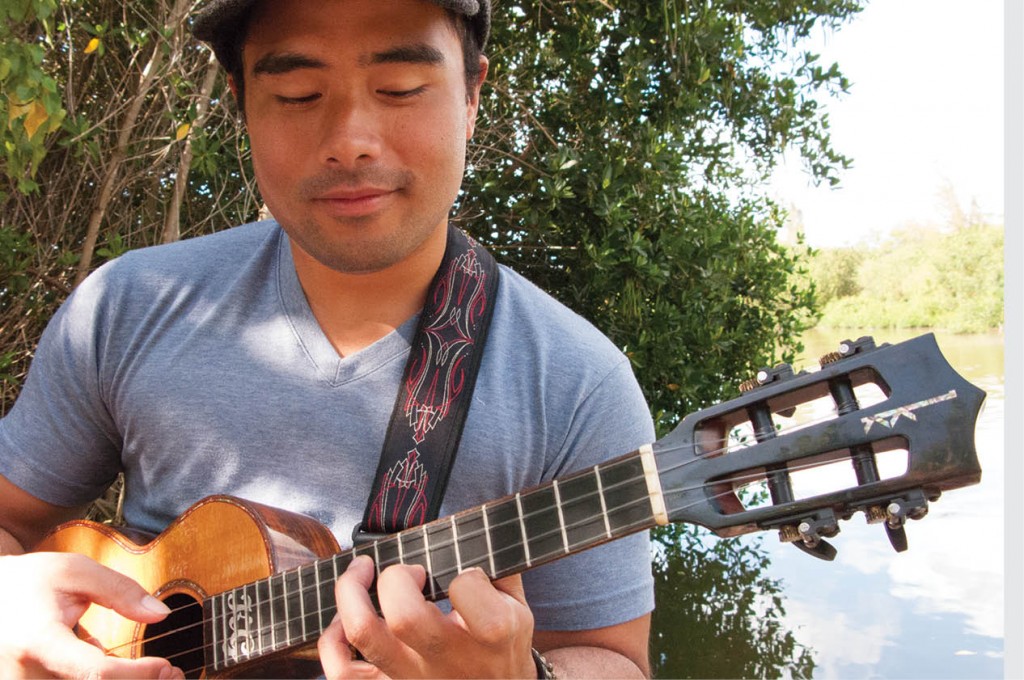
Kalei Gamiao in his backyard
For 27-year-old Kalei Gamiao, a rising star (hoku) among the new generation of ukulele solo instrumentalists, making a living means spending the majority of his time performing outside Hawaii. Kalei and his manager/father, Derek, meet me on the North Shore at one of their favorite local spots, Matsumoto Shave Ice. While waiting in line, Kalei begins to list all the countries he’s played over the last four years—Thailand, China, Singapore, the Philippines, Korea, Malaysia, and, of course, Japan, where Jake Shimabukuro initially built his following and scored a record deal with Sony.
“I love Japan. I can’t even count how many times I’ve been there,” Kalei says, the sky dimming for a moment before sprinkling on us.
By the time we exit Matsumoto’s—fluorescent pink, yellow, and blue shave ice in hand—the rain is gone and bright sun cracks through the clouds. Just minutes away from North Shore’s main drag, Kamehameha Highway, and down a dirt road, we retreat to Derek’s secluded, river-and-ocean-side property. By the river bank and under a canopy of trees, Kalei strums his Kamaka tenor and talks about his inspirations.“When I started picking up ukulele, I would go out and watch a lot of the local performers here. I was about 14,” Kalei says. “I followed Jake [Shimabukuro] and the guys from Pure Heart. They broke the traditional sound and gave the instrument a new voice, adapting techniques that people weren’t utilizing on ukulele. It was a huge inspiration to young players.”
After being approached at age 16 by a producer, Kalei started searching for his own sound—one created with the ukulele in mind. “I had never touched any other instrument before,” he says, adding that he felt an immediate connection to the ukulele. “I didn’t really think of the technical aspects, like I’m going to strum differently. It was more like, I like how this feels. That’s how my style evolved. I tried to re-create that same feeling that drew me to the instrument.” Derek chimes in: “Kalei realized he had to do something different, because. . . . there’s only one Jake. It doesn’t make sense to try to be like Jake. You have to create your own unique style.” Now working on his third album of original music, Kalei says he’s ready for the next phase of his career: “The mainstream market is what’s next. I want it on MTV—that’d be awesome!”
Derek adds that while “a lot of the U.S. doesn’t know about Kalei,” they’re hoping that his new album and a 2016 North American tour with Taimane Gardner will help change that.
“We were told it’s easier to come from the outside and work our way back into [the mainland],” Kalei says.
“But what about Hawaii?” I ask.
Kalei explains that he comes home to write songs, recharge, and connect with his mentors, including Benny Chong, Byron Yasui, Bryan Tolentino, and Kimo Hussey. “We all influence each other here,” he says, “especially in the ukulele world.”
But ultimately, Derek says, Hawaiian solo instrumentalists need to go abroad. “It’s a dime a dozen here. People from outside, they appreciate the ukulele. Not so much the Hawaii people. That’s just normal.”
Mirroring what Paulette had said about performing in Waikiki, Derek adds, “Musicians started doing it cheap for the hotels, and the hotels set that as the rate—‘I’ll just pay you $50 an hour and that’s it’—you can’t do that. Before they could stay in Hawaii, but not now.
“We people take ukulele for granted, and we take our music geniuses for granted. Everybody’s so laid back over here. When you go to L.A., you know a star. He’ll walk in and you know he’s a star. In Hawaii, it’s hard to know.
“They’re just . . . dressed in sandals.”
Tutu
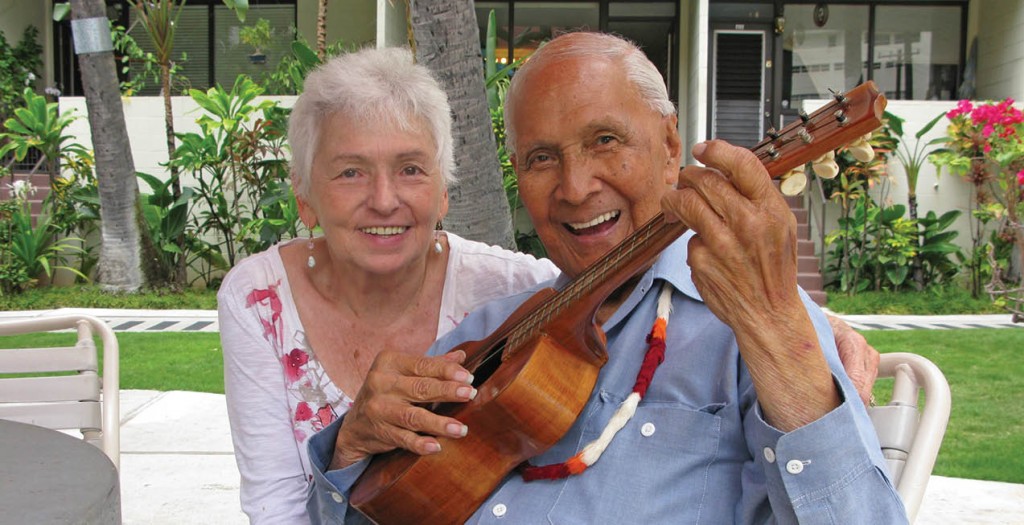
Myrna and Eddie Kamae
It’s tough to imagine the Kamaes, hiding in plain sight in Waikiki, living and working anywhere but Hawaii. The couple has spent the last three decades making documentary films, ten total, to ensure Hawaii’s tutus (elders)—many of whom mentored Eddie in Hawaiian language and song—have a place in its future.
A high-school dropout who had a three-year stint in jail, Eddie Kamae’s life could have gone sideways if not for the ukulele. When he was 15, Eddie says his oldest brother, who was a bus driver, brought home a ukulele he had found on a bus.
“My second oldest brother tuned the ukulele and played it,” Eddie recalls. “I watched him and loved the sound of the instrument. When they’d leave for work, I’d go and strum the ukulele—it was already in tune—and sit down next to the radio, playing along to whatever music came on. I loved Spanish music. It’s the rhythm section that I loved.”
He found a likeminded partner in Shoi Ikemi, with whom he formed the Ukulele Rascals, which had a unique repertoire that spanned from Cole Porter to Ravel—nearly every genre but Hawaiian music.
“At first he thought Hawaiian music was too simple,” Myrna explains over lunch, passing me a plate of fresh pineapple coated in li hing powder (salty dried plum) while Eddie digs into a bowl of ice cream.
So how did Kamae—who didn’t like Hawaiian music and didn’t speak Hawaiian—end up forming one of the most famous Hawaiian groups of all time and writing their now-classic songs?
As fate would have it, just around the time Kamae began jamming with the legendary slack-key guitarist Gabby Pahinui, he heard a song that changed his mind about Hawaiian music.
“Ku`u Pua i Paoakalani” was composed by Hawaii’s last queen, Lili`uokalani, while she lived under house arrest at the Iolani Palace after the overthrow of the Kingdom of Hawaii in 1893. Not knowing Hawaiian, Eddie wasn’t aware of the backstory; he simply liked the melody. Myrna, who is originally from Utah, adds that “like with a lot of cultures,” Hawaiians felt that teaching their children the native language would hold them back.
Eddie soon discovered that the melody was as much in the language as it was the music. One of his early Hawaiian language teachers, Mary Kawena Puku`i, sent him to Honolulu’s Bishop Museum, where they unearthed Queen Lili`uokalani’s handwritten poetry, which he turned into songs. Then Puku`i sent him to the remote valley of Waipi`o on the Big Island to study with Sam Li`a Kalainaina Jr., a composer and violinist who co-wrote “Kanaka Waiolina.”
“My teachers told me, ‘Write Eddie.’ They’d tell me the storyline of a song. I’d hear the storyline and know the rhythm like that,” says Eddie, snapping his fingers as he said “that.” While Eddie wrote, Myrna supported them with a job in educational television. “One of Eddie’s major gifts is his ability to take a song and arrange it in a way that it will live on, and be played by all kinds of people,” she says.
“They’ll never know that it was because Eddie spent six months, a year, or two years working on it until he got just the right sound. Over and over, you hear people playing that music he found through Sam Li`a, which would probably still be in museums.”
Eddie toured internationally with Sons of Hawaii as recently as 2010, but he never strayed too far for too long from Hawaii.
“He never wanted to leave,” says Myrna, in reference to the Waikiki apartment where they’ve been for nearly half a century.
Now, as Jake Shimabukuro and a younger generation of ukulele players are spreading aloha around the world, Myrna and Eddie are in awe of how far they’ve all come.
“I know it’s not great to have to travel all the time, but they are making a good living—finally—I think really for the first time,” she says. “People [abroad] seem to be very appreciative and respectful of the culture.”
“We spent all our savings doing research, instead of buying a house. Now they can do better.”
It all goes back to what Pilahi Paki told Eddie so many years ago, when he first started learning Hawaiian music: “What can the world learn from this little land in the middle of the Pacific? Love, respect, and kindness.”
Aloha.
New Easy Ukulele Song "We Shall Overcome" by 21 Songs in 6 Days: Learn Ukulele the Easy Way

https://youtu.be/lI2HayQsHrI We Shall Overcome Easy Ukulele Song - 21 Songs in 6 Days: Learn Ukulele the Easy Way
The origins of “We Shall Overcome” are not at all clear. Many scholars think that it is based on a gospel hymn called "I'll Overcome Someday” by Charles Albert Tindley published in 1901.
Tindley was the author of forty-five influential gospel hymns, including "We'll Understand It By and By" and "Stand By Me".
In February 1909 a letter printed on the front page of the United Mine Workers Journal says "Last year at a strike, we opened every meeting with a prayer, and singing that good old song, 'We Will Overcome'." It's not clear if this refers to Tindley's 1902 gospel song, since the lyrics and tune have not come down to us. The mention is significant, however, since this is the first mention of a song with this title being sung in a secular context and mixed race setting. It seems reasonable to suppose that this more militant version, or its memory, persisted underground in the labor movement during the 1920s to re-emerge during the 1930s and 1940s.
In fall 1945 in Charleston, South Carolina, members of the mostly female African American Food and Tobacco Workers Union began a five-month strike vs. the American Tobacco Company. To keep up their spirits during winter 1945–1946, strike leaders Lucille Simmons and Delphine Brown led a slow "long meter style" version of the gospel hymn "We'll Overcome" to end each day's picketing.
“We Will Overcome” was printed in Bulletin No. 3 (September 1948), of “People's Songs” with an introduction by union organizer Zilphia Horton saying that she had learned it from the Tobacco Workers' Union workers and had found it to be extremely powerful. Pete Seeger, learned it from Horton's version in 1947.
Frank Hamilton, who was a member of People's Songs and later The Weavers, picked up Seeger's version. Hamilton's friend Guy Carawan, learned the song from Hamilton. Carawan and Hamilton, accompanied by Ramblin Jack Elliot, visited the Highlander Folk School. In 1957, Seeger sang for an audience there that included Dr. Martin Luther King, Jr., who remarked how much the song had stuck with him. When, in 1959, Guy Carawan succeeded Horton as music director at Highlander, he reintroduced it at the school. It was the young (many of them teenagers) student-activists at Highlander, however, who gave the song the words and rhythms we know it by today when they sang it to keep their spirits up during the frightening police raids on Highlander and their subsequent stays in jail in 1959–60. In the PBS video “We Shall Overcome”, Julian Bond credits Carawan with teaching and singing the song at the founding meeting of the Student Nonviolent Coordinating Committee in Raleigh, North Carolina, in 1960. From there, it spread orally and became an anthem of Southern African-American labor union and civil rights activism.
Dr. Martin Luther King, Jr. recited the words from "We Shall Overcome" in his final sermon delivered in Memphis on Sunday March 31, 1968, before his assassination.
“We shall overcome. We shall overcome. Deep in my heart I do believe we shall overcome. And I believe it because somehow the arc of the moral universe is long, but it bends towards justice. We shall overcome because Carlyle is right; "no lie can live forever". We shall overcome because William Cullen Bryant is right; "truth crushed to earth will rise again". We shall overcome because James Russell Lowell is right:
Truth forever on the scaffold,
Wrong forever on the throne.
Yet that scaffold sways the future,
And behind the then unknown
Standeth God within the shadow,
Keeping watch above his own.
"We Shall Overcome" was sung days later by over fifty thousand attendees at Dr. King's funeral.
http://ukulele.io/Buy21Songs Learn to play ukulele the easy way with "21 Songs in 6 Days". And visit our website for more great ukulele lessons, tabs, and a FREE ebook http://ukulele.io/free-stuff-offer
To learn lots more ukulele chords, try our playlist https://www.youtube.com/playlist?list=PL5meDCz5zO-B8UjXstv_2WurNRGJyyWz8.
To spice up your strumming, try our playlist https://www.youtube.com/playlist?list=PL5meDCz5zO-DD1mcV8_t_tuga9MzOJA46
Want to learn to play the theme music from our intro? Check out https://youtu.be/YznUjC8pnUQ.
ukulele songs, easy ukulele songs for beginners, ukulele, ukulele songs for beginners, easy ukulele songs, beginner ukulele songs, We Shall Overcome
We Shall Overcome Easy Ukulele Song - 21 Songs in 6 Days: Learn Ukulele ...
Visit our website for more great ukulele lessons, tabs, and a FREE ebook http://ukulele.io/free-stuff-offer
https://youtu.be/lI2HayQsHrI We Shall Overcome Easy Ukulele Song - 21 Songs in 6 Days: Learn Ukulele the Easy Way
To learn lots more ukulele chords, try our playlist https://www.youtube.com/playlist?list=PL5meDCz5zO-B8UjXstv_2WurNRGJyyWz8.
To spice up your strumming, try our playlist https://www.youtube.com/playlist?list=PL5meDCz5zO-DD1mcV8_t_tuga9MzOJA46
Want to learn to play the theme music from our intro? Check out https://youtu.be/YznUjC8pnUQ.
The origins of “We Shall Overcome” are not at all clear. Many scholars think that it is based on a gospel hymn called "I'll Overcome Someday” by Charles Albert Tindley published in 1901.
Tindley was also the author of forty-five influential gospel hymns, of which "We'll Understand It By and By" and "Stand By Me" are among the best known.
In February 1909 a letter printed on the front page of the United Mine Workers Journal states that "Last year at a strike, we opened every meeting with a prayer, and singing that good old song, 'We Will Overcome'." Whether this refers to Tindley's 1902 gospel song cannot be determined, since the lyrics and tune have not come down to us. The mention is significant, however, since this is the first mention of a song with this title being sung in a secular context and mixed race setting. It seems reasonable to suppose that this more militant version, or its memory, persisted underground in the labor movement during the 1920s to re-emerge during its revival of the 1930s and 1940s.
In the fall of 1945 in Charleston, South Carolina, members of the Food and Tobacco Workers Union (who were mostly female and African American) began a five-month strike against the American Tobacco Company. To keep up their spirits during the cold, wet winter of 1945–1946, strike leaders Lucille Simmons and Delphine Brown led a slow "long meter style" version of the gospel hymn "We'll Overcome" to end each day's picketing.
During the Presidential Campaign of Henry A. Wallace, “We Will Overcome” was printed in Bulletin No. 3 (September 1948), of “People's Songs” with an introduction by union organizer Zilphia Horton saying that she had learned it from the interracial Congress of Industrial Organizations (CIO) Food and Tobacco Workers' Union workers and had found it to be extremely powerful. Pete Seeger, a founding member, and for three years Director of People's Songs, learned it from Horton's version in 1947. Seeger writes: "I changed it to 'We shall'... I think I liked a more open sound; 'We will' has alliteration to it, but 'We shall' opens the mouth wider; the 'i' in 'will' is not an easy vowel to sing well [...]."
Frank Hamilton, who was a member of People's Songs and later The Weavers, picked up Seeger's version. Hamilton's friend Guy Carawan, learned the song from Hamilton. Carawan and Hamilton, accompanied by Ramblin Jack Elliot, visited the Highlander Folk School. In 1957, Seeger sang for an audience there that included Dr. Martin Luther King, Jr., who remarked how much the song had stuck with him. When, in 1959, Guy Carawan succeeded Horton as music director at Highlander, he reintroduced it at the school. It was the young (many of them teenagers) student-activists at Highlander, however, who gave the song the words and rhythms we know it by today when they sang it to keep their spirits up during the frightening police raids on Highlander and their subsequent stays in jail in 1959–60. In the PBS video “We Shall Overcome”, Julian Bond credits Carawan with teaching and singing the song at the founding meeting of the Student Nonviolent Coordinating Committee in Raleigh, North Carolina, in 1960. From there, it spread orally and became an anthem of Southern African-American labor union and civil rights activism.
Dr. Martin Luther King, Jr. recited the words from "We Shall Overcome" in his final sermon delivered in Memphis on Sunday March 31, 1968, before his assassination.
“We shall overcome. We shall overcome. Deep in my heart I do believe we shall overcome. And I believe it because somehow the arc of the moral universe is long, but it bends towards justice. We shall overcome because Carlyle is right; "no lie can live forever". We shall overcome because William Cullen Bryant is right; "truth crushed to earth will rise again". We shall overcome because James Russell Lowell is right:
Truth forever on the scaffold,
Wrong forever on the throne.
Yet that scaffold sways the future,
And behind the then unknown
Standeth God within the shadow,
Keeping watch above his own.
"We Shall Overcome" was sung days later by over fifty thousand attendees at Dr. King's funeral.
ukulele songs, easy ukulele songs for beginners, ukulele, ukulele songs for beginners, easy ukulele songs, beginner ukulele songs, We Shall Overcome
Subscribe to:
Posts (Atom)
